Editor’s note: This is the fifth in a series of stories which will be published on Fort Atkinson Online documenting the fatal firetruck crash of Dec. 17, 1923, which was described by the then-“Jefferson County Union” as the “worst tragedy in the city’s history.”
By Chris Spangler
As Fort Atkinson pays tribute to three firefighters killed while enroute to a blaze 100 years ago, the tragedy evokes personal memories for one local family.
Mary Beyerly, of Fort Atkinson, and her brother, Gerald F. Moore, of Ashville, N.C., are the grandchildren of Frank E. Hoffman, one of the men who died in the firetruck crash on Dec. 17, 1923. Mary’s daughters, Martha McWilliams and Betsy Gasper, also reside in Fort Atkinson.
Hoffman and five other firemen were aboard the city’s new American LaFrance triple-combination pumper when it struck a culvert and careened off the south side of U.S. Highway 12 into a field, just west of Fort Atkinson, while responding to a Rockdale house fire.
In addition to Hoffman, 42, an 18-year fire department veteran who with his older brother, Harry Sr., owned the Hoffman Lumber Co., the dead included William Gross, 54, and Herman Smith, 59. Three other firefighters were injured.
“Frank Hoffman would’ve been my grandfather, whom, of course, I never knew because when the accident happened, my mom was only 10 years old,” Mary said. “He was very young and my mom was an only child.”
Frank married Clara V. Barney on Sept. 8, 1904; she was born in 1882 and died in 1961 at age 79. Mary’s mother, Geraldine, was born in 1913. She passed away in 1995 at the age of 83.
Mary’s father, Fred Moore, owned Healthway Dairy in Fort Atkinson, located where Nasco is today.
“He also coincidentally worked at Hoffman Lumber Co. at one point, which was my grandfather’s lumber company when he passed away,” she said, noting that her father was a draftsman or working in a similar position there when her parents got married.
“I remember Hoffman Lumber Co. being on Madison Avenue (where Ace Hardware is) as a little girl,” Mary added.
Founded in 1888 by W.O. Hoffman, the lumber company was destroyed by fire on June 2, 1962. Harry Sr. and his son, Harry Jr., were the owners at the time, according to a story in the June 4, 1962, edition of the Daily Jefferson County Union.
“Harry (Sr.) and Mabel were quite influential people,” Mary said of her great-uncle and -aunt. They had a son … involved in the lumber company.”
She said she does not have many stories to tell about her grandfather or the fatality, likely because her mother was only 10 years old at the time of the crash and her grandmother did not talk about it much later in life.
She did recall seeing a photo of him as a young man, possibly in their wedding picture. But she does not remember any in a firefighter’s uniform.
“Grandma didn’t talk about the crash or Grandpa. She really didn’t. I feel bad now that I should’ve asked,” Mary said. “I just knew that I never had a grandpa. It was my grandma that was there. I never questioned it, I guess.”
One main recollection
But one thing about the 1923 firetruck — at the end of its serviceable life — does stands out in her memory.
“My mom had told me that they saved the frame of this firetruck and they put it in two places: possibly McCoy Park and then they moved it out to the park behind the swimming pool in the playground for children to play on,” she said.
Mary described her mother and/or grandmother being angry about the city allowing the firetruck to be considered for play equipment. She said she assumes they were talking about the truck in which her grandfather and two fellow firefighters died, but is not certain. Mary did recall an old firetruck being placed at Rock River Park down by the creek where the Rotary Club-built bridge now is located.
“I knew she was upset because she told us that was the firetruck her father was killed on, and it should be respected and it shouldn’t be a place where kids can play. I remember that vividly at the time,” Mary said.
Firefighter Mike Reel, who with fellow firefighter Jimmy Slocum has been researching the 1923 truck and fire department’s history, located articles shedding some, albeit not extremely bright, light on that memory.
They, in turn, relate to discussion of building the Fort Atkinson municipal swimming pool, which garnered strong community support but did not officially open until July 19, 1955.
Reel said that a year earlier, according to the minutes of a June 16, 1954, city council meeting, City Manager Elmore Klement reported that a path would run north from the (Sinnissippi Park, later renamed Rock River Park) bathhouse to an area near the creek, where a children’s playground area would be installed. The path would continue over the creek to a picnic area.
“This is a very important find in the research,” Reel said. “Over the years, we have heard stories of playground equipment in this area that involved an old firetruck that the children played on. We have very little history on the firetruck that was used as play equipment. All we have heard over the years was there had been playground equipment and a firetruck involved.”
Reel said that he spoke to retired Fire Chief Tom Emrick, whose family resided near the park on Wilson Street in the late 1960s.
“They recall playground equipment on the west side of the present-day trail, just south of the creek,” Reel said of the Emricks. “This is also the recalled location of the firetruck they played on. The only playground equipment that was located on the east side of the present-day trail was the merry-go-round.
“This is indicative of the fairly significant poured concrete slab that is still present to this day near the south-side creek bridge, on the east side of the present-day walking trail which supported the merry-go-round mounting base,” he added.
Even a cement slab is not concrete proof, however. So Reel had to go back further in time seeking answers.
He noted that on March 22, 1958, the Daily Union printed a photo showing a new 1948 Quad American LaFrance pumper next to the department’s 1919 White truck.
“The only significance this has to the 1923 American LaFrance pumper is that it was never mentioned in this article of going anywhere,” Reel said. “The 1923 American LaFrance truck we know was repaired and not replaced based on earlier documentation. The 1923 American LaFrance pumper that was tragically involved in the crash would now be 25 years old at this point in time, standing by for service right next to the new 1948 Quad American LaFrance pumper.”
The Feb. 13, 1953, issue of the Daily Union published the first mention of building a new municipal swimming pool. However, Reel said, it got “caught up in much talk and some controversy from location to costs.”
He noted that the pool eventually ended up in Rock River Park over the secondary Ralph Park location, went over budget and underwent many project delays.
Meanwhile, on July 5, 1955, the Daily Union reported the purchase of an American LaFrance triple-combination fire pumper. It still had not arrived by the end of the year.
Reel said that, according to a story in the Jan. 5, 1956, Daily Union, when the new truck arrives, the department will have to decide what to do with the old 1923 “big-wheeled pumper that figured in the tragic Rockdale run shortly after it had been purchased 33 years ago.
“The four-stall fire station (then located on North Water Street West behind the municipal building) was now filled to capacity and the 1923 truck was destined to go out when the new pumper arrived,” Reel said. “The fire department would like to have kept the 1923 truck on hand, if storage space for it could be found. It was pointed out that despite its age and a cracked (motor) block, the old LaFrance was still a strong pumper to have in case of a severe downtown fire.”
Reel noted that at this time, the 1923 truck was 33 years old, well past its expected life expectancy of 25 years.
That especially was the case, he pointed out, for “a truck that had been involved in such a horrendous accident as this truck had been. This pumper owed nothing back to this community, as it performed and protected its community residents, businesses, as well as our visitors who passed through our fine community, on a daily basis. This truck had truly passed the test of time.”
On Jan. 24, 1956, the newspaper reported the arrival of the new $24,000, 1,000-gallon-per-minute pumper truck. The next day, the Daily Union wrote a story headlined: “New Fort Atkinson fire truck impressive piece of machinery; you’ll see lot of it.”
Reel said the truck was considered cutting edge.
“One thing that I noticed during my reading (was) this new pumper was our first-ever enclosed cab in our firetruck history,” he said. “Because it sported the enclosed cab, it was also noted as being heated. And think of the safety factor an enclosed cab offered, unlike all other previous trucks, including the 1923 pumper. What an improvement, but little, if anything, was mentioned about these features. It was 1956, I guess.”
Reel noted that the story goes on to mention some of the department’s truck history, but not before full-time driver Louis Whidby was quoted as saying that he has seen the department grow in value and efficiency since 1924, shortly after the city purchased the American LaFrance high-wheeled pumper it apparently was retiring now.
“This last paragraph is referencing the 1923 American LaFrance that was involved in the crash, but repaired and put back into service for another 33 years,” Reel said. “It is interesting that this is again mentioned (as to) what may become of the 1923 American LaFrance pumper, as this new 1956 American LaFrance just may replace it.”
So what really was happening with the 1923 truck?
The Feb. 8, 1956, issue of the Daily Union published a photo with a caption reading: “Old firetruck won’t be children’s toy yet. City keeps 1923 pumper, may up rural fees.”
“This is a huge find in the history. However, it still didn’t report the final end. As of this Feb 8th, 1956, writing, the city kept the truck,” Reel said.
The Daily Union story on that date stated: “Fort Atkinson’s oldest piece of firefighting apparatus isn’t going into retirement yet. The city council Tuesday night decided not to do away with the big-wheeled old American LaFrance pumper that has been on fire duty here since 1923.
“The old truck, which figured in the city’s greatest fire department tragedy shortly after it was put into service, has been shoved out of its honored place in the fire station by the arrival of the new $24,000 (1956 American LaFrance) or FAFD Truck 6 in January.”
The story stated that the 1923 pumper was being housed at the water utility garage where the Water Department truck had been and it likely would remain there until next summer at the very least. The water utility truck, meanwhile, would be parked outside.
“Fire Chief Pearson Gebhardt had recommended that the 33-year-old truck be disposed of, that it might probably be stripped of most of its valuables and placed in one of the city’s parks as a playground attraction for the youngsters,” the story read. “However, that suggestion didn’t find much favor on the council. Most of the councilmen seemed to feel that the truck should be retained for a while yet … and not for sentimental reasons either.
“It was pointed out that, even though the engine has a cracked block and that the tires might not hold up under fast driving, the ancient vehicle could render valuable pumper service in case of a bad fire,” according to the newspaper story.
The Daily Union wrote that City Manager Klement “expressed the belief that the cost of upkeep and storage for the truck might be more that the old truck is worth. But Councilman Wally Goeglein, a member of the fire department, argued that it is still a good piece of equipment and said he’d like to see it around if an emergency ever called for the pumping of water right out of the river.”
Reel said that the debate led to another firefighting issue, that being fire-protection contracts with surrounding rural towns. Discussed was the possibility that the tanker truck owned by the towns being housed in the city’s fire department might not be occupying a stall there after the next summer, thus making room for the 1923 truck again.
“One of the councilmen expressed it this way: ‘It’s ridiculous to send a $24,000 piece of equipment out on country roads for only $75 (per rural call),” Reel said. “That came after the report that the new truck will be the first in line for rural calls.”
Which brings us back to today.
As three Fort Atkinson firefighters are being mourned a century after their deaths, Reel and Slocum continue their painstaking research about the fate of the 1923 firetruck.
However, finding the answer is no longer a mission.
It is a quest.
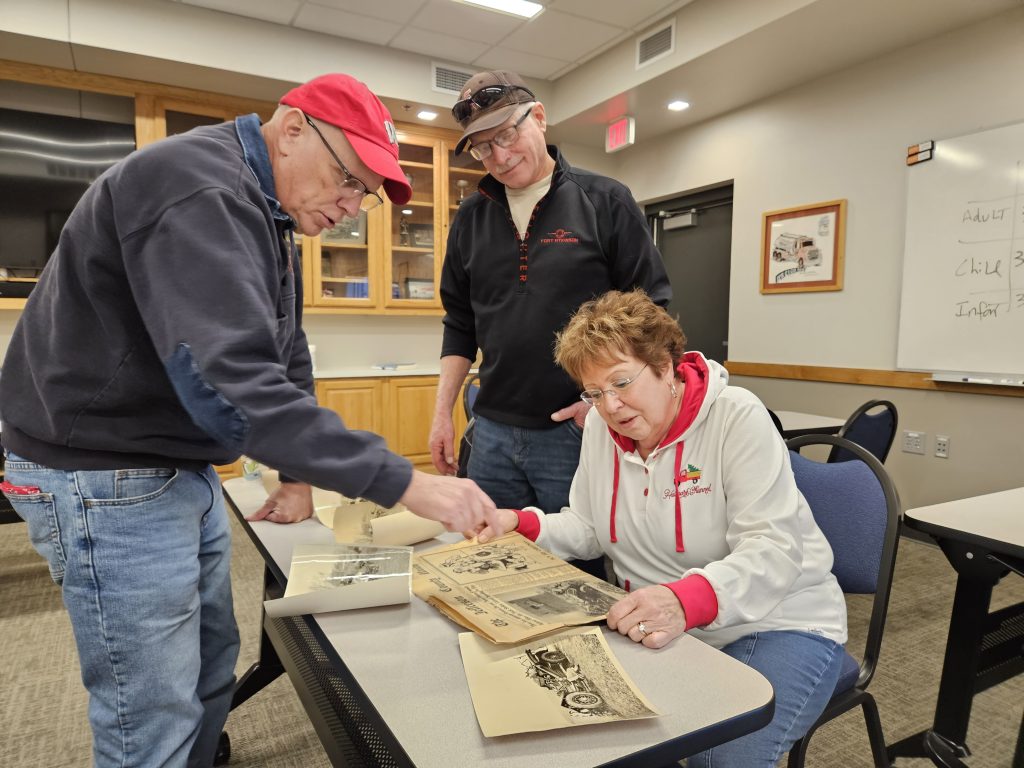
Firefighters Mike Reel, at left, and Jim Slocum share with Mary Beyerle, Fort Atkinson, photos and newspaper clippings of the firetruck crash that claimed the life of her grandfather, Frank E. Hoffman, on Dec. 17, 1923. Chris Spangler photo.
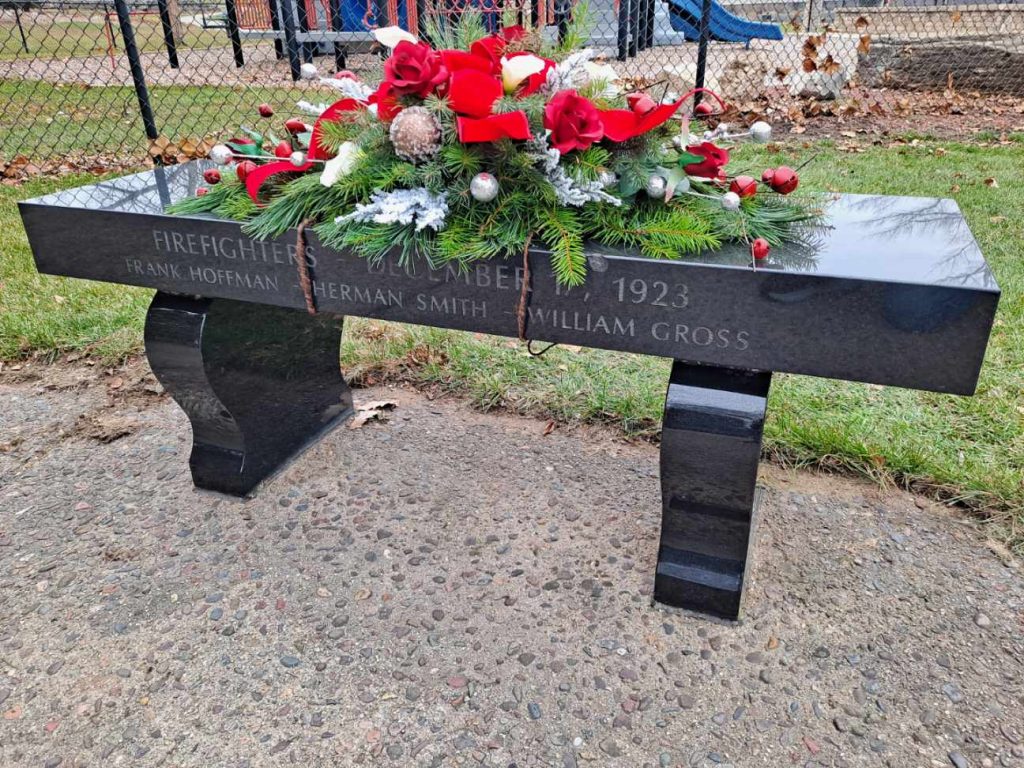
Flowers, courtesy of Humphrey Floral, decorate a memorial bench in Lorman-Bicentennial Park. Inscribed on the bench are the names of three firefighters killed in a truck crash Dec. 17, 1923: Frank Hoffman, William Gross and Herman Smith. Photo courtesy of Mike Reel.
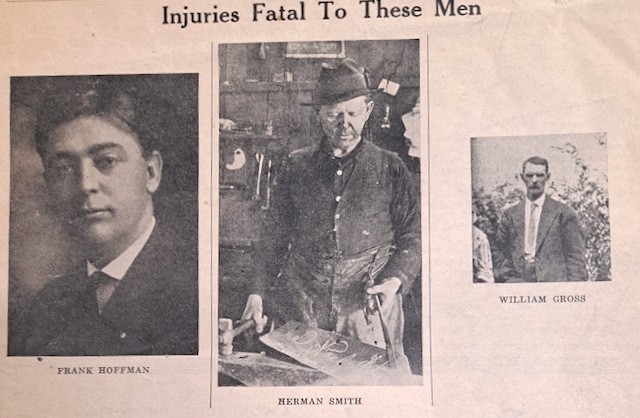
Frank Hoffman, at left, is among three firefighters killed in a firetruck crash in 1923. The obituaries of the three men killed in the crash appeared that year on the front page of the “Jefferson County Union,” then a weekly publication. Photo courtesy of the Fort Atkinson Fire Department.
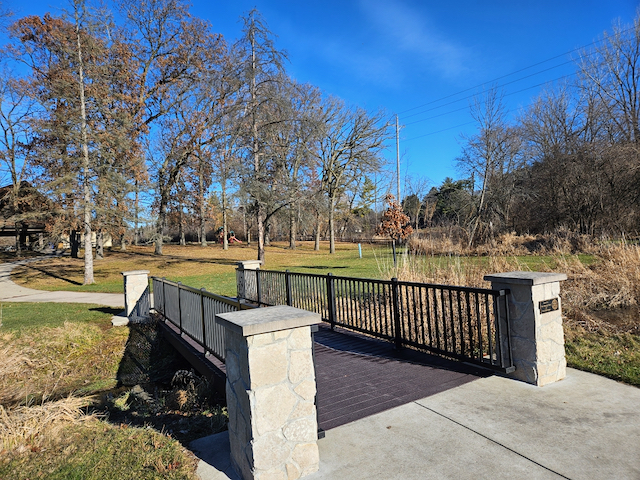
The Fort Atkinson Rotary Club bridge spans a creek in Rock River Park. Some evidence points to a time when a retired firetruck, perhaps the 1923 pumper, may have been placed for use as playground equipment on a cement pad in the area near the bridge. Chris Spangler photo.
This post has already been read 3543 times!
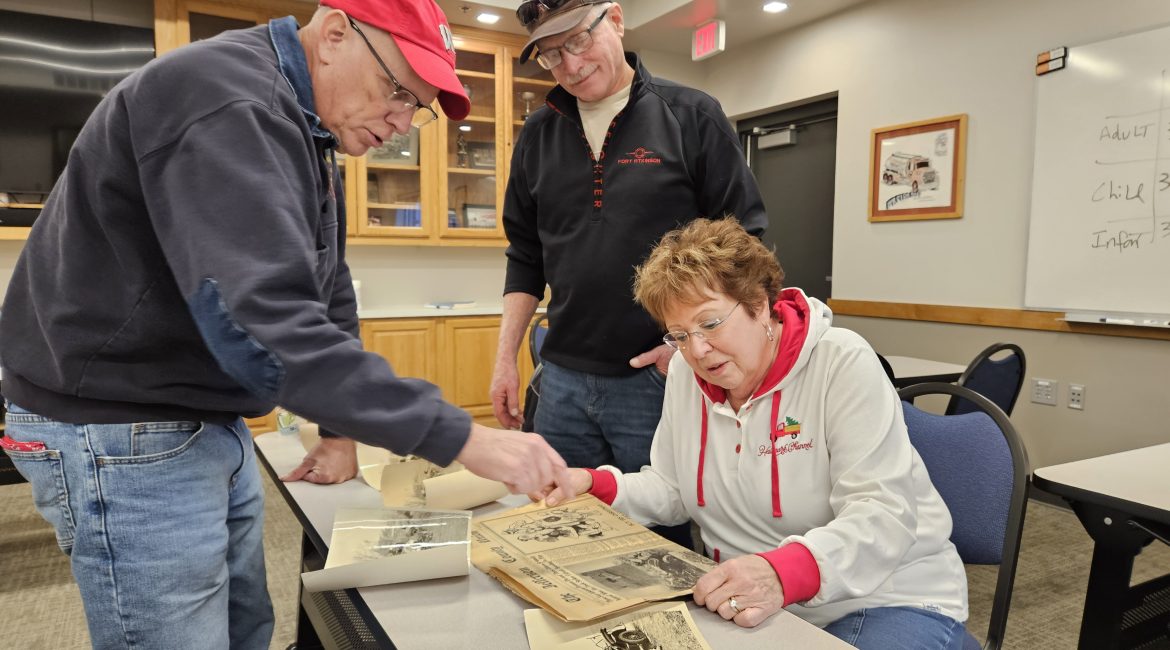
Keep looking !